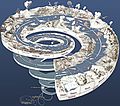Bild:Geological time spiral (de).jpg

Grött vun disse Vörschuu: 676 × 600 Pixels. Anner Oplösungen: 271 × 240 Pixels | 541 × 480 Pixels | 865 × 768 Pixels | 1.154 × 1.024 Pixels | 2.416 × 2.144 Pixels.
Originaldatei (2.416 × 2.144 Pixel, Grött: 3,54 MB, MIME-Typ: image/jpeg)
Datei-Historie
Klick op de Tiet, dat du de Datei ankieken kannst, so as se do utseeg.
| Datum/Tiet | Duumnagelbild | Grött | Bruker | Kommentoor | |
|---|---|---|---|---|---|
| aktuell | 10:50, 22. Sep. 2016 |  | 2.416 × 2.144 (3,54 MB) | MagentaGreen | Beschriftung korrigiert |
| 13:21, 9. Aug. 2016 |  | 2.416 × 2.144 (3,92 MB) | Gretarsson | das falsch im Paläozoikum platzierte NEOGEN durch KARBON ersetzt; Termini MISSISSIPPIUM und PENNSYLVANIUM ergänzt, da sich dies aufgrund einer bereits vorhandenen Zeitmarke im Karbon anbot | |
| 15:38, 7. Aug. 2016 |  | 2.416 × 2.144 (3,86 MB) | MagentaGreen | == {{int:filedesc}} == {{Information |Description={{de|1=Ein Diagramm der geologischen Zeitskala}}{{en|1=A diagram of the geological time scale}}{{eo|1=Diagramo montranta la geologian temposkalon }}{{fr|Diagramme montrant l'... |
Dateibruuk
Kene Siet bruukt dat Bild.
Allmeen Datei-Bruuk
Disse annern Wikis bruukt disse Datei:
- Bruuk op cs.wikipedia.org
- Bruuk op de.wikipedia.org
- Bruuk op frr.wikipedia.org
- Bruuk op hu.wikipedia.org
- Bruuk op rm.wikipedia.org




